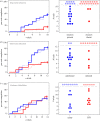Cleaner wrasse indirectly affect the cognitive performance of a damselfish through ectoparasite removal
- PMID: 29514969
- PMCID: PMC5879620
- DOI: 10.1098/rspb.2017.2447
Cleaner wrasse indirectly affect the cognitive performance of a damselfish through ectoparasite removal
Abstract
Cleaning organisms play a fundamental ecological role by removing ectoparasites and infected tissue from client surfaces. We used the well-studied cleaning mutualisms involving the cleaner wrasse, Labroides dimidiatus, to test how client cognition is affected by ectoparasites and whether these effects are mitigated by cleaners. Ambon damselfish (Pomacentrus amboinensis) collected from experimental reef patches without cleaner wrasse performed worse in a visual discrimination test than conspecifics from patches with cleaners. Endoparasite abundance also negatively influenced success in this test. Visual discrimination performance was also impaired in damselfish experimentally infected with gnathiid (Crustacea: Isopoda) ectoparasites. Neither cleaner absence nor gnathiid infection affected performance in spatial recognition or reversal learning tests. Injection with immune-stimulating lipopolysaccharide did not affect visual discrimination performance relative to saline-injected controls, suggesting that cognitive impairments are not due to an innate immune response. Our results highlight the complex, indirect role of cleaning organisms in promoting the health of their clients via ectoparasite removal and emphasize the negative impact of parasites on host's cognitive abilities.
Keywords: Labridae; Pomacentridae; coral reef fish; learning and memory; mutualism; pathogen infection.
© 2018 The Author(s).
Conflict of interest statement
We declare we have no competing interests.
Figures



References
-
- Lochmiller RL, Deerenberg C. 2000. Trade-offs in evolutionary immunology: just what is the cost of immunity? Oikos 88, 87–98. (10.1034/j.1600-0706.2000.880110.x) - DOI
-
- Gegear RJ, Otterstatter MC, Thomson JD. 2005. Does parasitic infection impair the ability of bumblebees to learn flower-handling techniques? Anim. Behav. 70, 209–215. (10.1016/j.anbehav.2004.09.025) - DOI
Publication types
MeSH terms
LinkOut - more resources
Full Text Sources
Other Literature Sources
